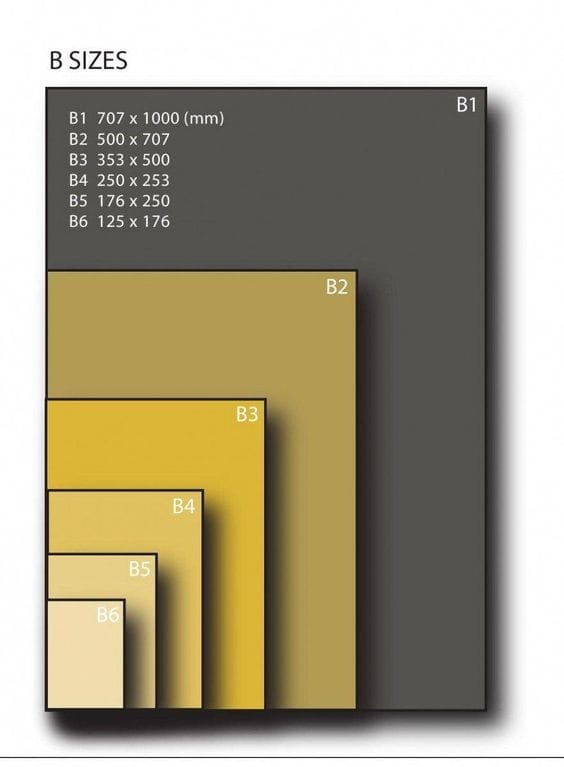Notebooks have different sizes, and they are of different types. Read our FAQ guide to learn more about the different types of notebooks and their sizes.
1. Common notebook sizes
So what are the common notebook paper sizes in use today? Let’s see some of them.
1.1 A series of notebook sizes
The A Series paper size is the most popular notebook size found in many English-speaking countries across the world. This size is the size of choice in those countries, and it uses the international ISO 216 paper standard with a special aspect ratio of a square root of two.

- A1 notebook size
- 594mm x 841mm (23.3 inches x 33 inches)
- With their larger size, you can fit more on each page and have plenty of space to write, draw, and doodle.
- A2 notebook size
- 420mm x 594mm (16.5 inches x 23.3 inches)
- A2 notebooks are the perfect size for taking notes and drawing sketches. They’re also great for scrapbooking and other crafts.
- A3 notebook size
- 297mm x 420mm (11.7 inches x 16.5 inches)
- A3 notebooks are perfect for artists, designers, and anyone who needs to take large notes or sketches. The notebook is twice the size of a standard A4 notebook, so you have plenty of space to work.
- A4 notebook size
- 210mm x 297mm (8.3 inches x 11.7 inches)
- The A4 notebook is another common size slightly smaller than the A Series. This one is also used in Anglophone countries and is half of the A Series. This size is commonly used by students in primary school as it is much lighter. (A4 Notebook: The Most Comprehensive Guide)
- A5 notebook size
- 148mm x 210mm (5.8 inches x 8.3 inches)
- The A5 size is half of the A4. To get this size, the A4 sheet will be folded in half. A5 notebooks are very small pocket-size notebooks used for jotting down memos and important points and data. They are unconventional writing materials and are not used in formal educational settings.
- A6 notebook size
- 105mm x 148mm (4.1 inches x 5.8 inches)
- The smaller version of the A5 is the A6. It is much smaller and serves the same purpose as the former. A6 notebooks are popularly used in offices for clerical work. (A6 Notebook: The Most Comprehensive Guide)
1.2 B series of notebook sizes
Another type of notebook paper size is the B Series. It is not as common as the A-Series and is used for special applications.

- B1 notebook size
- 707mm x 1000mm (27.8 inches x 39.3 inches)
- The B1 notebook‘s pages are wide and spacious, making it easy to write or draw whatever you need.
- B2 notebook size
- 500mm x 707mm (19.7inches x 27.8 inches)
- B3 notebook size
- 353mm x 500mm (10.1 inches x 13.9 inches)
- B4 notebook size
- 250mm x 353mm (10.1 inches x 13.9 inches)
- B5 notebook size
- 176mm x 250mm (7.2 inches x 10.1 inches)
- B5 notebook is the most common notebook size in the series and is calculated using the geometric mean of an A Series size. This notebook is the middle size between the A4 and the A5 size sheet. (The B5 Notebook: Some Brief Introduction)
- B6 notebook size
- 125mm x 176mm (5 inches x 7.2 inches)
- The B6 size is not as popular as the B5, and it is used for special applications like creative crafts.
1.3 Here are some comparison pictures of common notebook sizes

2. International Sizes vs. U.S. Paper Sizes
International sizes are different from US paper sizes. While international measurements use A and B series sizing, the US uses ANSI paper sizes. This site is not only common in the US but also in Canada and North American countries and islands. Also called letter paper, academic and business documents are printed on them, and over the years, they have become the standard paper measurement in the region.
Letter papers are 3 inches longer than international paper sizes and are often used for accounting documents, contracts, and notebooks.
3. Popular notebook sizes in different countries
Here are different notebook sizes used in different countries.
3.1 Card book or card-size notebook
The smallest notebook size is the card book or Card Size notebook. It has a 55 x 90 MMS or 2.16 x 3.54 dimension. This small card book size can fit into a pocket, small bag, or pen case. Card book notebooks are used for jotting quick memos, making lists, and making simple notes. They are mostly used in homes and offices. Their compact size makes it easy to hold and transport them. You can use them on the move to jot down important details, which you can then transfer to a much larger book at a convenient time.
- Popular in the US

3.2 Passport-size notebook
Another very common notebook size is the passport-size notebook. It is called passport size because it is the same size as an international passport. This one measures 90 x 125 MMS or 3.54 x 4.92 inches. Just like the card book size, it is a small notebook for jotting down numbers, quick notes, and short memos. It can also be used as a travel journal or diary. The purpose is to keep important information and numbers.
- Popular in the UK

3.3 Pocket-size notebook
A pocket-size notebook is very small and measures 90 x 140 MMS or 3.5 x 5.5 inches in dimension. It was popularized by Field Notes Brand. It looks like a passport-size version but with extra space for drawing up to-do lists. They fit nicely into pockets.
- Popular in Germany and France

3.4 B6 notebook
B6 Notebook measures 128 x 182 MMS or 5.03 x 7.16 inches. It is a standard notebook size in North America. B6 sizes have simplified lines and are great for note-taking and journaling. They are also lightweight and easy to carry.
- Popular in the US and Canada

3.5 A5 notebook
This version comes in different formats; some can contain as many as 400 pages or more. Bound by stitches, A5 notebooks are the standard notebooks for schoolwork and clerical entries. The cover is either made with light or thick paper, and some with hardcover. The lighter version has fewer pages ranging from 100 to 192 or 200 pages. A5 notebooks are also used by artists and bookkeepers; that is why they are called the jack of all trades when it comes to notebook sizes because you can use them to do many things. From the A5, you get the A6 series.
- Popular in English-speaking countries

3.6 B5 notebook
The B5 has 190 x 250 MMS or 7.48 x 9.84 inches dimensions and is often sold with blank pages. It can be used as a scrapbook, a planner, or a practical notebook. The pages are extra wide, and they come in different width sizes. B5 books can also be used to make journal entries, but many people don’t use them for that because most of them don’t have lines.
- Popular in French-speaking countries

3.7 Standard-size notebook
A standard-size notebook is an everyday notebook used by all and sundry. It measures 110 x 210 MMS or 4.33 x 8.26 inches and has matching vertical and horizontal lines. It is popularly used for journaling, and general text writing m standard notebooks influenced many other notebook sizes; that is why it is called a foundational size that produced many other sizes.
- Popular in South Africa

Here’s a Notebook Size Chart that includes common notebook sizes along with their dimensions and common uses.

| Notebook Size | Dimensions (inches) | Dimensions (cm) | Common Uses |
|---|---|---|---|
| 3.5 x 5.5 | 9 x 14 | On-the-go notes, quick sketches | |
| A6 | 4.1 x 5.8 | 10.5 x 14.8 | Compact notes, lists, small sketches |
| B6 | 5.0 x 7.0 | 12.5 x 17.6 | Compact note-taking, planning |
| A5 | 5.8 x 8.3 | 14.8 x 21 | Note-taking, journaling, drawing |
| B5 | 6.9 x 9.8 | 17.6 x 25 | Note-taking, projects, writing |
| Half Letter | 5.5 x 8.5 | 14 x 21.6 | Writing, planning, organization |
| Letter | 8.5 x 11 | 21.6 x 27.9 | Note-taking, projects, writing |
| A4 | 8.3 x 11.7 | 21 x 29.7 | Note-taking, larger sketches, writing |
| Composition | 7.5 x 9.75 | 19.1 x 24.8 | School, writing, projects |
| Legal | 8.5 x 14 | 21.6 x 35.6 | Note-taking, longer writing |
- Please note that these dimensions are approximate and can vary slightly based on the manufacturer. Also, the common uses are general suggestions and can vary depending on personal preferences and needs.
4. Why do we need so many notebook sizes?
Many notebook sizes are required to satisfy the needs of different users. Size varieties give users options when making a choice. Here are some more reasons why it is ideal to have many notebook sizes.

4.1 Suitable for different applications

We all need notebooks. For different things. Children need soft-cover notebooks for their school work; business people need hard-cover notebooks to enter their records; bookkeepers, accountants, and storekeepers use them to prepare their books of accounts; and so on and so forth. These are different applications that require different sizes.
While a small size may be appropriate for a business person who doesn’t write down very much, a record keeper will require a large notebook because he writes down a lot of data. So different sizes are ideal for different applications.
4.2 Suitable for different people

Different sizes suit different people. Some people prefer large notebook sizes, while others prefer smaller sizes—it is all about user preference. It is a fact that notebook manufacturers produce according to customer demand for size.
4.3 To fit in some bags

Many people consider their bag sizes when shopping for notebooks. If their bags are too small, they will find it difficult to carry the notebook around. Bags have different sizes ranging from small, medium, and big sizes. While a big bag can accommodate a book of any size, a medium or small bag may not. This is especially true for school bags. Children’s bags range from small to medium; some notebooks will not fit into them because they are too big.
4.4 Price differences

Another reason why we need different notebook sizes is that we all have different budgets. What one can afford may be too much for another buyer. Notebooks are priced differently, and one of the major determinants of price is size. By offering different sizes to buyers, manufacturers are providing different options so people can go for the ones they can afford.
5. Select Notebook size according to your needs
For backpacks, there is really no size requirement for notebooks because most notebooks will fit into the average backpack because backpacks are bigger. However, it is the needs of the user that will determine the type of notebook they use. While size may not be an issue for backpack users, weight does. Students may not care too much about the size because the more pages they have for school work, the better, but office workers may prefer lighter books with fewer pages.

Conclusion:
Notebook sizes vary based on the type and what they are designed for. Sizes also differ based on location too. Some notebooks are popular in some countries but largely unused in others. While the A series version is popular in English-speaking countries, the B series is popular in North America and many French-speaking countries. Before you make your pick, decide on what you want to use the notebook for. Your page requirement should also matter but note that notebooks with more pages weigh more than notebooks with fewer pages. Besides page numbers, page thickness also affects overall weight too, so bear this in mind.








